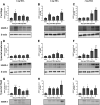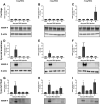Sodium Monoiodoacetate Dose-Dependent Changes in Matrix Metalloproteinases and Inflammatory Components as Prognostic Factors for the Progression of Osteoarthritis
- PMID: 33995052
- PMCID: PMC8113822
- DOI: 10.3389/fphar.2021.643605
Sodium Monoiodoacetate Dose-Dependent Changes in Matrix Metalloproteinases and Inflammatory Components as Prognostic Factors for the Progression of Osteoarthritis
Abstract
Osteoarthritis (OA) is a degenerative joint disease that primarily affects people over 65 years old. During OA progression irreversible cartilage, synovial membrane and subchondral bone degradation is observed, which results in the development of difficult-to-treat chronic pain. One of the most important factors in OA progression is joint inflammation. Both proinflammatory and anti-inflammatory factors, as well as extracellular matrix degradation enzymes (matrix metalloproteinases (MMPs), play an important role in disease development. One of the most widely used animal OA models involves an intra-articular injection of sodium monoiodoacetate (MIA) directly into the joint capsule, which results in glycolysis inhibition in chondrocytes and cartilage degeneration. This model mimics the degenerative changes observed in OA patients. However, the dose of MIA varies in the literature, ranging from 0.5 to 4.8 mg. The aim of our study was to characterize grading changes after injection of 1, 2 or 3 mg of MIA at the behavioral and molecular levels over a 28-day period. In the behavioral studies, MIA injection at all doses resulted in a gradual increase in tactile allodynia and resulted in abnormal weight bearing during free walking sequences. At several days post-OA induction, cartilage, synovial membrane and synovial fluid samples were collected, and qPCR and Western blot analyses were performed. We observed significant dose- and time-dependent changes in both gene expression and protein secretion levels. Inflammatory factors (CCL2, CXCL1, IL-1β, COMP) increased at the beginning of the experiment, indicating a transient inflammatory state connected to the MIA injection and, in more severe OA, also in the advanced stages of the disease. Overall, the results in the 1 mg MIA group were not consistently clear, indicating that the lowest tested dose may not be sufficient to induce long-lasting OA-like changes at the molecular level. In the 2 mg MIA group, significant alterations in the measured factors were observed. In the 3 mg MIA group, MMP-2, MMP-3, MMP-9, and MMP-13 levels showed very strong upregulation, which may cause overly strong reactions in animals. Therefore, a dose of 2 mg appears optimal, as it induces significant but not excessive OA-like changes in a rat model.
Keywords: cartilage; chronic pain; inflammation; matrix metalloproteinases; osteoarthritis; pain; synovial fluid; synovial membrane.
Copyright © 2021 Bryk, Chwastek, Mlost, Kostrzewa and Starowicz.
Conflict of interest statement
The authors declare that the research was conducted in the absence of any commercial or financial relationships that could be construed as a potential conflict of interest.
Figures









Similar articles
-
Cartilage protective and anti-analgesic effects of ALM16 on monosodium iodoacetate induced osteoarthritis in rats.BMC Complement Altern Med. 2019 Nov 21;19(1):325. doi: 10.1186/s12906-019-2746-7. BMC Complement Altern Med. 2019. PMID: 31752825 Free PMC article.
-
Persistent synovial inflammation plays important roles in persistent pain development in the rat knee before cartilage degradation reaches the subchondral bone.BMC Musculoskelet Disord. 2018 Aug 16;19(1):291. doi: 10.1186/s12891-018-2221-5. BMC Musculoskelet Disord. 2018. PMID: 30115046 Free PMC article.
-
Resveratrol, a natural antioxidant, protects monosodium iodoacetate-induced osteoarthritic pain in rats.Biomed Pharmacother. 2016 Oct;83:763-770. doi: 10.1016/j.biopha.2016.06.050. Epub 2016 Jul 30. Biomed Pharmacother. 2016. PMID: 27484345
-
The role of cytokines in osteoarthritis pathophysiology.Biorheology. 2002;39(1-2):237-46. Biorheology. 2002. PMID: 12082286 Review.
-
The role of inflammatory mediators and matrix metalloproteinases (MMPs) in the progression of osteoarthritis.Biomater Biosyst. 2024 Feb 21;13:100090. doi: 10.1016/j.bbiosy.2024.100090. eCollection 2024 Mar. Biomater Biosyst. 2024. PMID: 38440290 Free PMC article. Review.
Cited by
-
Network analysis of monoamines involved in anxiety-like behavior in a rat model of osteoarthritis.Pharmacol Rep. 2024 Feb;76(1):72-85. doi: 10.1007/s43440-023-00562-5. Epub 2024 Jan 5. Pharmacol Rep. 2024. PMID: 38180634 Free PMC article.
-
Chondroitin sulfate-functionalized lipid nanoreservoirs: a novel cartilage-targeting approach for intra-articular delivery of cassic acid for osteoarthritis treatment.Drug Deliv. 2022 Dec;29(1):652-663. doi: 10.1080/10717544.2022.2041130. Drug Deliv. 2022. PMID: 35188017 Free PMC article.
-
Intra-articular nanoparticles based therapies for osteoarthritis and rheumatoid arthritis management.Mater Today Bio. 2023 Feb 26;19:100597. doi: 10.1016/j.mtbio.2023.100597. eCollection 2023 Apr. Mater Today Bio. 2023. PMID: 36910270 Free PMC article.
-
Imaging Study on Acupuncture Inhibiting Inflammation and Bone Destruction in Knee Osteoarthritis Induced by Monosodium Iodoacetate in Rat Model.J Pain Res. 2022 Jan 11;15:93-103. doi: 10.2147/JPR.S346242. eCollection 2022. J Pain Res. 2022. PMID: 35046719 Free PMC article.
-
Description of Novel Molecular Factors in Lumbar DRGs and Spinal Cord Factors Underlying Development of Neuropathic Pain Component in the Animal Model of Osteoarthritis.Mol Neurobiol. 2024 Mar;61(3):1580-1592. doi: 10.1007/s12035-023-03619-x. Epub 2023 Sep 21. Mol Neurobiol. 2024. PMID: 37731080 Free PMC article.
References
-
- Berlinberg A., Ashbeck E. L., Roemer F. W., Guermazi A., Hunter D. J., Westra J., et al. (2019). Diagnostic performance of knee physical exam and participant-reported symptoms for MRI-detected effusion-synovitis among participants with early or late stage knee osteoarthritis: data from the Osteoarthritis Initiative. Osteoarthr. Cartilage 27 (1), 80–89. 10.1016/j.joca.2018.09.004 - DOI - PubMed
LinkOut - more resources
Full Text Sources
Other Literature Sources
Miscellaneous

